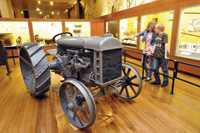Time to portray agriculture as a modern industry

London’s Science Museum boasts that its “astonishing science, historic collections, awesome galleries and inspirational exhibits” make it one of the top visitor attractions in the country.
It is the largest museum of its kind in the world, containing more than 200,000 exhibits covering almost every sector of science, technology, industry and medicine. Many of the exhibits are interactive, so visitors can explore and discover for themselves. The museum draws children and families from all over the UK and beyond, entertaining and informing them of the wonders of science, including climate change and biotechnology.
It is every child’s dream – but for one exception, the agriculture exhibit. This seems trapped in a time warp and unrelated to everything else on view. Instead of exciting the visitor with the amazing advances made in farm machinery, food production and environmental stewardship, all the visitor will see is a nostalgic homage to an era of farming long gone.
There are static displays of typical farm scenes behind glass windows, showing small-scale agriculture just after the Second World War and into the 1950s.
These presentations look rather like the wooden farmyard toyboxes that would have been familiar to children in the 1960s.
These displays look dated against the high-tech backdrop of everything else and are not that engaging. The signposting around these scenes appears archaic and, at times, inaccurate. An intricate metal frieze along one wall depicts farming from ancient Greece to the “modern day”. The Science Museum’s take on modern day shows a metal sculpture of a helicopter crop spraying a field. The main piece of machinery on display is a Fordson Model F tractor dating from 1917.
World Class
There is no sense of the present or future in farming – for example, no references to managing water, soils or wildlife habitats. No mention of fuel or pharmaceutical crops, of livestock genetics or the challenges of producing enough food to feed a growing global population.
While some might enjoy this trip down memory lane, it does nothing to improve public understanding about this country’s leadership in crop science or our world-class skills in marrying quality food production with sustainable management of the countryside and environment. The agriculture exhibit makes no attempt to ignite enthusiasm in young people for farming as a positive career choice.
Thousands of children and teenagers pass through the doors of the Science Museum every week. On the basis of what they can see at the moment, it is hard to imagine that many would be persuaded to find out more about farming. The current collection of exhibits simply does not compete well for the visitor’s time. It is all too easy to get lured by the shiny, noisy, interactive and fun displays which call to the visitor to come and play and learn.
The agriculture exhibit has plenty of space, but the lighting, messaging and objects on show are completely wrong. It presents a picture of British farming that is so far from the truth – one that is divorced from technological progress, not highly skilled, on its last legs and struggling to survive. This is sad, depressing, embarrassing and, most importantly, completely inaccurate.
So why has the agriculture exhibit been so neglected? A small delegation from the industry was so disturbed by this state of affairs that it challenged the directors of the Science Museum to explore ways of doing better.
Massive investment has gone in to developing the museum in line with a demanding public in recent years. Museums generally are pretty stretched in keeping visitor numbers up at a time when so many other leisure activities, such as multimedia entertainment at home, compete for people’s time.
There has been a five-year plan to refurbish and update different galleries at the Science Museum, but agriculture has been bottom of the priority list.
A number of factors have influenced this. The museum directors had not fully appreciated the extent to which agriculture had progressed. Their focus for modernisation has been swayed towards displays where sponsorship has been available. The agriculture exhibit has also been blighted by one major problem – its floor carries asbestos and to remove it could cost as much as £150,000 even before the exhibition is given a makeover. In total, it could cost as much as £4m to completely overhaul the agriculture exhibit.
Government cutbacks have hit the museum sector and it needs to reduce its operating costs by more than £13m. It is questionable whether there is any prospect in the near future of updating the farming exhibit.
But this is where UK’s agricultural industry could come in. In these austere times, £4m for an exhibition makeover sounds like a hefty sum but maybe not too much for an industry as diverse as farming.
Is there scope for enlightened machinery manufacturers, agri suppliers, retailers and processors to join forces to raise the funds and come up with some creative ways of bringing this exhibit alive? A combined effort could build a legacy worth far more than £4m in its long-term benefit to farming.
Helping children choose farming as a career
• Christine Tacon, managing director of Co-operative Farms, led a delegation to the Science Museum to question why the agriculture exhibit had not been improved. Here is her view:
 The display reminded me of the one I used to see as a child in the Castle Museum in Norwich displaying the Stone Age, Bronze Age and Iron Age. My concern is that much of the Science Museum now is about future science while the agriculture exhibit isn’t.
The display reminded me of the one I used to see as a child in the Castle Museum in Norwich displaying the Stone Age, Bronze Age and Iron Age. My concern is that much of the Science Museum now is about future science while the agriculture exhibit isn’t.
For example, the climate-change exhibition, GM foods and understanding how your body works are all very inspirational. No child would choose to come into agriculture as a result of the farming display, any more than they would want to go and live in the Stone Age.
The industry needs to get behind showing farming’s use of leading-edge technology: what we are doing to reduce greenhouse gas emissions, adapting to climate change and how we are caring for the environment and wildlife while being super efficient at what we do.
We need to show tractors that steer themselves, how we map fields for nutrients and yields and therefore calculate the best use of inputs. Clearly, we also need to show differing standards in animal welfare, maybe comparing our standards to the US and continent, and certainly the conditions in which different types of eggs are produced.
A good exhibition would be one that made a city child consider getting involved in food technology, environmental science or even deciding they would rather be a tractor driver than a train driver.
